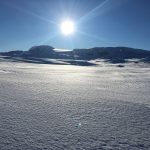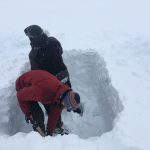
The NFR funded project SNOWPACE (2017-2021) aimed to constrain the sources of the Norwegian winter season snow pack from stable water isotopes.
Current climate and weather prediction models provide information to better prepare against precipitation extremes, and to manage hydropower resources, now and in a future climate. The atmospheric water cycles contribute largely to uncertainty in model simulations. Models continue to use established parameterizations for processes such as evaporation and cloud microphysics, while increasing to every higher resolution. This implies an urgent need for validating these model’s water cycle with new and additional observations. Within the SNOWPACE project, we addressed this need through the enabling the use of stable water isotope measurements to constrain atmospheric moisture transport from source to sink.
During the SNOWPACE project, we established the observational basis by coordinated field sampling of water vapour, rain and snow events, and the the Norwegian winter snow pack. SNOWPACE used the new national infrastructure FARLAB to obtain high-quality measurement data. A combination of sophisticated numerical modeling tools was used to decipher and extract the information contained in the isotopic measurements, providing new constraints of the atmospheric water cycle to the modelling community. The new knowledge obtained within SNOWPACE opens pathways to constrain processes and improve parameterizations in weather and climate models, and for the management of natural resources in a changing climate. The legacy of the project are a range of open-access data sets of all measurements collected during the project.
Fieldwork during SNOWPACE
Field measurements were a central element of the SNOWPACE project. During the project, measurement campaigns were designed specifically to test the use of stable water isotope measurements on short time scales for gaining insight into atmospheric processes, and to enable numerical model development and evaluation.
Climatological measurements in Bergen 2016-2020
Paired daily and event sampling of the isotopic composition of vapour and precipitation at the Geophysical Insitute, Bergen, from December 2016 to March 2020
Measurements during the Iceland-Greenland Seas Project 2018
Vapour and precipitation measurements on land, ship, and research aircraft in coordination with hydrographic and atmospheric measurements during the IGP project, from 28 Feb to 20 March 2018
Measurements at Finse Alpine Research Centre during winter 2018/2019
Continuous vapour and precipitation sampling with 7 Intense Observation Periods to monitor the build-up of the winter snow pack, from 7 December 2018 to 5 February 2019.
Citizen Science snow sampling during Easter 2018 and 2019
Distributed sampling from Easter ski tourists in the Norwegian mountains, involving participants from Bergen and Oslo, during April 2018 and April 2019
Measurements at Finse Alpine Research Centre during peak accumulation 2020
Spatially distributed vapour and precipitation sampling around Finse to assess the spatial representativeness of the isotopic signal of different weather situations, from 16 March to 05 May 2020.
Datasets and data management
The legacy of the SNOWPACE project is a collection of datasets that enable more detaild process understanding and constraining the water cycle in isotope-enabled models, from weather prediction to climate time scales. Ultimately, this will also contribute to more accurate predictions of extreme events and snow accumulation in Norway and the North Atlantic region. To enable use by the community, all field measurement data from the SNOWPACE will be made available in public repositories, either as part of peer-reviewed publications or by itself in databases.
Read more about the SNOWPACE datasets here
Modelling work during SNOWPACE
Stable water isotopes contain an integrated signal of the phase change history of water vapour during its atmospheric lifetime. Evaporation conditions provide the initial imprint, that is further modified by mixing processes during transport, condensation and precipitation formation and growth, and the exchange of liquid precipitation with the atmosphere during fall. The complexity of this information content requires in most situations the use of sophisticated tools to decipher different pieces of information from vapour and precipitation observations (Gimeno et al., 2021).
Read more about modelling work during SNOWPACE here
Dissemination
Read more about dissemination activity from the SNOWPACE project
Publications from the SNOWPACE project
Read more about publications during and related to the SNOWPACE project
Project participants, partners, and collaborators
Affiliations are given that were valid at the time of project collaboration




